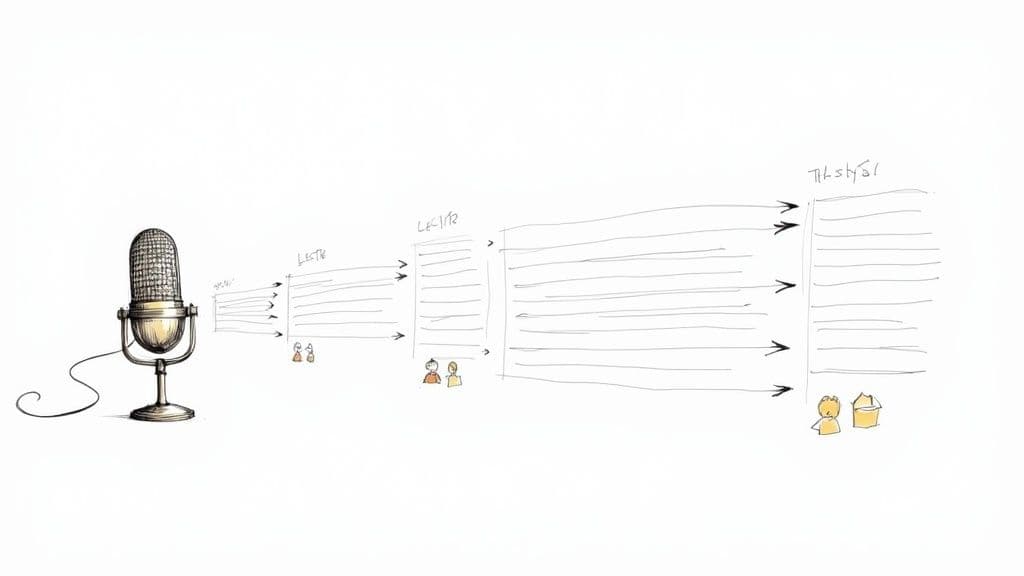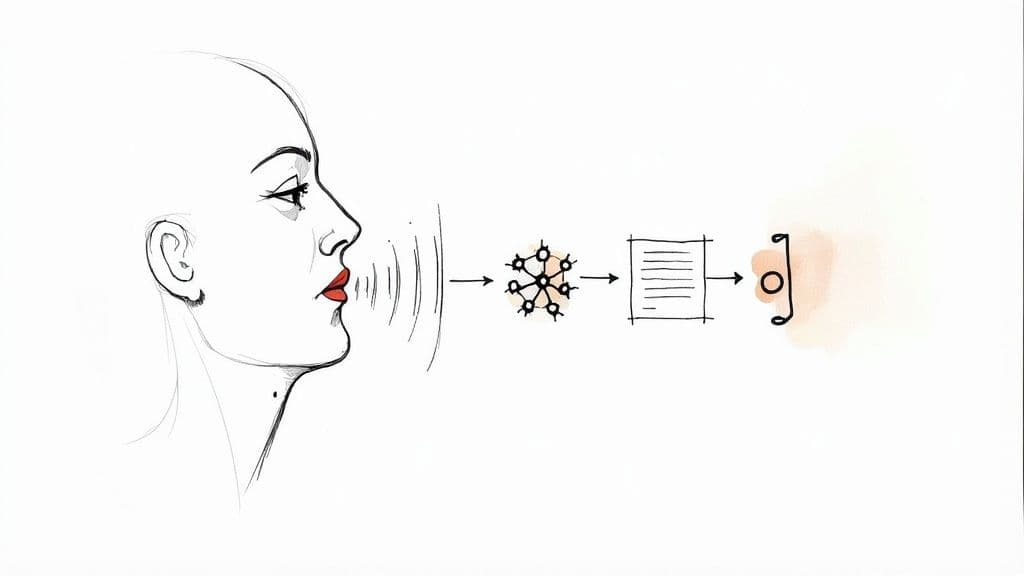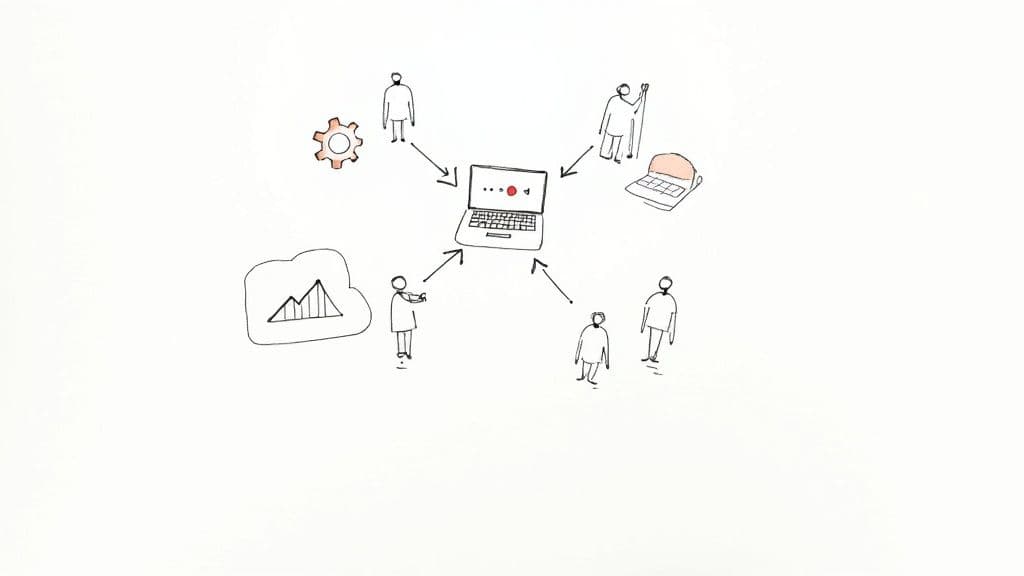On the surface, to transcribe something is simply to convert spoken words into written text. But this dictionary definition barely scratches the surface of the true transcribe meaning and its impact.
Think of it this way: transcription turns a fleeting moment—a podcast interview, a brainstorming session, a lecture—into a permanent, searchable, and usable asset. It’s the bridge between a conversation that just happened and data you can act on forever. Understanding the meaning of transcribe is the first step in unlocking the value hidden within your audio and video content.
So, What Does it Mean to Transcribe in the Real World?
Let's say you just wrapped up a fantastic podcast interview. Right now, that conversation only exists as an audio file. But once you transcribe it, those spoken words become a blog post that Google can index, a series of quotes for social media, or a searchable document you can reference months from now. That transformation is the essence of the transcribe meaning.
This process, once a painstakingly manual job, has been revolutionized by AI-powered workflows, making it incredibly fast and accessible. This shift is a major reason why demand is surging across almost every industry, from legal teams needing depositions to marketers turning webinars into SEO-friendly content. In fact, the U.S. transcription market was valued at USD 30.42 billion and is expected to grow at a compound annual rate of 5.2% through 2030. You can read more about the transcription market boom to see just how big it's getting.
The real transcribe meaning isn't just about typing out what was said. It's about unlocking the value trapped inside your audio and video files, making them accessible, searchable, and ready to be repurposed.
Ultimately, the goal of transcribing something boils down to a few key benefits:
- Making content accessible: A transcript opens up your audio and video content to people who are deaf or hard of hearing.
- Making content searchable: A transcript lets search engines (and you) find specific information buried inside a recording with a simple Ctrl+F.
- Making content repurposable: It provides the raw material to create articles, show notes, social media updates, and countless other pieces of written content.
Picking the Right Type of Transcription for Your Needs
Not all transcripts are created equal. Understanding the meaning of transcribe is really about picking the right tool for the job, as the best method depends entirely on what you plan to do with the text afterward. The transcript a lawyer needs for court evidence looks completely different from what a marketer needs to turn a podcast into a blog post.
Making this choice is the very first step in turning raw audio into something genuinely useful. This simple decision tree helps clarify when transcription is the right move.
The logic is pretty straightforward: if you have spoken audio and you need a written record of it, transcription is your next step. This is the fundamental process that unlocks all the value hiding in your audio files.
Verbatim Transcription: Every Single Syllable
Verbatim transcription is the most literal, warts-and-all version you can get. It captures every single word, sound, and non-verbal utterance—we’re talking filler words like "um" and "uh," false starts, stutters, and even background noises like a cough or a door slamming shut.
This method provides an unfiltered, raw account of what was said and how it was said. It's absolutely essential for situations where a speaker's hesitations are as important as their words. This is the preferred method for legal depositions, psychological evaluations, or deep-dive research interviews where every nuance matters.
Clean Read Transcription: Polished for Clarity
In contrast, clean read (sometimes called intelligent verbatim) focuses on readability over raw detail. The transcriber actively edits out all the filler words, stutters, and conversational tics that make spoken language look messy on the page. The goal is a polished, easy-to-read text that preserves the speaker's original meaning without all the distractions.
This is the go-to method for content creation. If you’re turning a podcast interview into a blog post or a webinar into an article, clean read transcription delivers a professional final product that's ready for an audience. It ensures your readers get the core message without getting bogged down in conversational noise.
To help you decide which approach is right for your project, here’s a quick breakdown of the most common transcription types.
Transcription Types at a Glance
| Transcription Type | What It Captures | Best Use Case |
|---|---|---|
| Verbatim | Every word, filler, stutter, and background noise. | Legal proceedings, qualitative research, police interviews. |
| Clean Read | The core message, edited for clarity and readability. | Blog posts, articles, marketing content, meeting notes. |
| Timestamped | Text synced with audio/video time markers. | Video captioning, editing, journalism, academic research. |
Each type serves a distinct purpose, so matching the format to your goal is key to getting a transcript that truly works for you.
Timestamped Transcription: Syncing Text with Audio
Finally, timestamped transcription adds another layer of data by syncing the written text to specific points in the audio or video file. Timestamps, often formatted as [HH:MM:SS], are inserted at regular intervals or whenever a new speaker begins.
This is indispensable for video editors who need to create subtitles or captions, as it precisely locates where each line of dialogue occurs. Researchers and journalists also rely on it to quickly find and reference specific quotes within a long recording. For a deeper dive into turning audio into text for various purposes, you can explore our detailed guide on audio to text conversion.
How AI Is Redefining the Transcribe Meaning
Artificial intelligence hasn't just improved transcription—it's completely changed the game. Today, the very meaning of transcribe is intertwined with AI, which has made turning audio into text faster, cheaper, and more accessible than ever before. This process is powered by a technology called Automatic Speech Recognition (ASR), which is essentially software trained to listen and type out what it hears.
The biggest benefit here is speed. A human might spend hours transcribing a single hour of audio, but an AI service can deliver a full transcript in just minutes. This rapid turnaround is a huge advantage for content creators, journalists, and anyone needing to process audio efficiently and cost-effectively.
But it’s important to keep a realistic perspective on what AI can—and can't—do.
The Power and Pitfalls of AI
AI transcription is incredibly powerful, but it’s far from perfect. The technology often stumbles over real-world complexities that a human ear handles with ease. For instance, AI models tend to produce less accurate transcripts when they encounter:
- Thick accents or dialects that weren't part of their training data.
- Background noise, like the clatter of a coffee shop or passing traffic.
- Multiple speakers talking over one another.
- Industry-specific jargon or complex, niche terminology.
AI absolutely excels at speed and scale, making it a fantastic tool for creating first drafts or general-purpose transcripts. However, for mission-critical tasks where 99%+ accuracy is the only option, human expertise remains the gold standard.
This technological shift has ignited a massive market boom. The global AI transcription industry, valued at USD 4.5 billion, is projected to rocket to USD 19.2 billion by 2034. You can discover more insights about the AI transcription market to see just how fast it's growing. This explosion highlights how integral AI has become to the modern transcribe meaning.
If you're curious about how specific tools stack up, you can check out our guide on if ChatGPT can transcribe audio. Knowing AI’s limitations is key—it helps you decide when to leverage it for speed and when to bring in a human for that final, critical layer of precision.
Transcription in High-Stakes Industries
In some fields, the meaning of transcribe goes way beyond simple convenience. For these high-stakes industries, getting the words right isn't just a goal—it's a non-negotiable requirement. A single mistake can trigger significant consequences, making precise transcription an essential part of the workflow.
Nowhere is this truer than in the medical world. Medical transcription involves converting a doctor's spoken notes, patient histories, and diagnostic observations into formal electronic health records (EHRs). Precision is paramount. A misplaced decimal point or a misunderstood medical term could alter a patient's diagnosis and treatment plan. This specialized skill demands a deep knowledge of complex terminology.
The need for this level of accuracy has created a massive market for specialized software. The global medical transcription software market was valued at USD 2.55 billion and is on track to hit USD 8.41 billion by 2032, all driven by the need for perfect documentation. You can dig deeper into the growth of medical transcription technology on Fortune Business Insights.
Legal and Academic Applications
The legal sector is another arena where every single word carries immense weight. Legal transcription creates the official written record for court proceedings, depositions, and witness interviews. In this context, a verbatim transcript is often the standard, capturing the exact phrasing, pauses, and even the hesitations that can influence a case's outcome.
For legal professionals, a transcript isn't just a summary—it's evidence. To be admissible in court, it must be a faithful, unaltered reflection of the spoken record.
In the same vein, academic researchers rely heavily on transcription for qualitative data analysis. When they conduct interviews or focus groups, scholars transcribe the audio to systematically code themes, identify patterns, and analyze what was said. This process transforms hours of conversation into structured data, paving the way for rigorous, defensible research.
For both law and academia, the ability to accurately capture the intended meaning is fundamental to the integrity of the work itself.
It's easy to get the terms transcription, translation, and captioning mixed up—they all involve words, after all. But each one serves a completely different function, and picking the right one is key to getting what you actually need for your project.
Think of transcription as the foundational step. It’s the simple act of converting spoken words from an audio or video file into written text, all within the same language. The goal is pure documentation. If you have a product announcement in English, the transcription is just that announcement written down in an English text file.
Translation Changes the Language
Now, translation is a different process entirely. It takes existing text and converts it from one language to another. It doesn't listen to audio; it reads text. Its whole purpose is to break down language barriers. So, that English transcript of our product announcement? A translator would take that text and turn it into Spanish for a new audience.
Captioning Adds a Time Element
Finally, we have captioning, which is built specifically for video. This process involves creating time-coded text that syncs perfectly with the dialogue and important sounds on screen. It’s what makes videos accessible to viewers who are deaf, hard of hearing, or just watching with the sound off in a quiet office.
Key Takeaway: Transcription is speech to text (same language). Translation is text to text (different languages). Captioning is time-synced text for video.
Let's put it all together. For a single 30-second video announcement, the results would look like this:
- Transcription: You get a plain text file containing every English word spoken.
- Translation: You get a text file of those same words, but now they're in Spanish.
- Captioning: You get a special file (like an SRT) with time-coded English text that pops up on the screen exactly when the words are spoken.
If you're diving into the world of video, our complete guide on how to caption videos breaks down that entire process step-by-step.
For another hands-on look at putting this into practice, check out this excellent guide on creating videos with closed captions.
Common Questions About the Meaning of Transcribe
Even after you grasp the transcribe meaning, a few practical questions often arise. How good is AI transcription, really? And can a simple text file actually help people find your podcast online? Let's clear the air on some of the most common queries.
Nailing these details down helps you pick the right tool for the job, whether you're creating content, doing research, or making your work more accessible.
How Accurate Is AI Transcription?
This is the big one. Under perfect conditions—think crystal-clear audio, one speaker, no complex jargon—AI transcription can achieve up to 95% accuracy. But real-world conditions are rarely perfect. That's why human transcriptionists still hold the crown, consistently delivering 99%+ accuracy. They understand nuance, navigating thick accents, background noise, and industry-specific terms that can confuse algorithms.
For anything mission-critical, like legal or medical files, a human review is still the gold standard. For most other tasks, like getting a rough draft of a blog post from a podcast episode, AI gets you most of the way there in minutes.
A huge factor in accuracy isn't the file type, but the recording quality. Clear audio with minimal background noise and distinct speakers is the single most important element for getting a solid transcript, whether it's from AI or a human.
Can Transcription Help With SEO?
Absolutely. When you transcribe your audio and video—like podcasts, webinars, or tutorials—and post that text on your website, you're giving search engines a wealth of indexable content. Google can't listen to your audio file, but it can read every single word of your transcript. This is a common starting point for many creators, and there are even resources like this practical guide on how to get a transcript from a YouTube video that walk you through it.
This simple step helps you rank for specific keywords you mentioned, makes your content accessible to a much wider audience, and boosts overall engagement. It’s one of the easiest and most effective wins in content marketing.
Ready to unlock the value hidden in your audio and video files? At meowtxt, we make transcription fast, accurate, and affordable. Drag and drop your file and get a high-quality transcript back in minutes, with no subscriptions needed. Get started today by visiting https://www.meowtxt.com.



